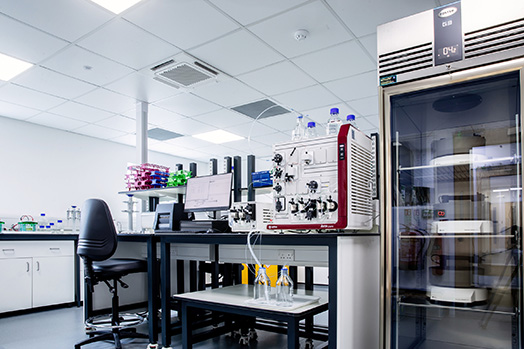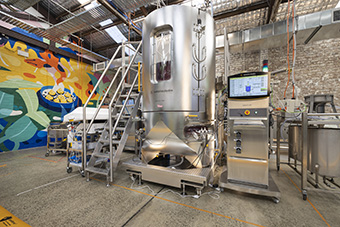

Talking Heads: Red-tape revolutionaries
Having spoken with experts wielding the scissors to cut through the complexity of regulations, Louise Davis learns how companies bringing novel foods to market can best navigate the challenging compliance landscape
It would be easy to write this article as a takedown piece on the overly complicated, headache-inducing political nightmare that surrounds the rollout of novel foods. And the experts canvassed here certainly have their fair share of criticism for some of the bureaucracy they are having to endure in a bid to get their products onto shelves. But nobody we’ve spoken with would ever say that regulations themselves are not necessary. Anyone reputable that’s producing food – or ingredients for food – wants their products to be both safe and legal as the absolute bare minimum. And an article simply grumbling about the current state of play wouldn’t help anyone.
So, instead we have opted to focus on both the positive and the future. What can be done to assist people in traversing this difficult landscape? How can companies help themselves avoid getting tangled up in red tape? What should legislators and policymakers be doing to clear the path ahead? And are things really as bad as we’ve heard?
On that final question, the answer is a hesitant ‘no’. As ever, Singapore is a beacon, in terms of issuing regulatory approvals and hence the subsequent product launches that follow. All of our experts cite the Singapore Food Agency as an example of how policymakers can do regulation well.
And in the USA, things are also looking rosier: although no insect products have been approved (yet), products produced via precision fermentation and cell cultivation are all currently being approved.
It’s probably not surprising that the European Union is lagging behind. Timelines are frustratingly slow and there are several pain points regularly cited, including
no meaningful pre-submission advice, long dossier-validation times, and long risk-assessment times.
Looking at novel foods as a whole – so, including plant protein, plant/fermentation, algae, fermentation, and insects – 244 novel food dossiers have been submitted in the EU. Of those, 38 have been withdrawn or terminated, 63 are under EFSA validation, 84 are under EFSA risk assessment, and 59 are with EFSA opinion. And of those 244 dossiers that have been submitted, there are currently 100 approved novel foods.
Cultivating change
None of those approved are for cultivated meat. In fact, no dossiers have yet been submitted for cell-cultivated meat products, although, interestingly, in May 2023 the European Food Safety Authority (EFSA) did say it’s ready and waiting for cultivated meat/seafood submissions. Exemplifying the (lab-grown) chicken-and-egg situation perfectly, the sooner dossiers are submitted, the sooner the EFSA will be forced to think about cultivated meat and we should see some more progress.
Other players are also pushing for greater advancement in the EU. In October 2023, EIT Food, which is co-funded by the EU, launched its own policy recommendations on protein diversification. The Accelerating Protein Diversification for Europe policy brief calls for a systems-thinking approach to “diversifying protein sources and transforming our food system to be healthier and more sustainable for all”. Its recommendations cover everything from enabling policy environments, regulations, farming, right through to going to market. A useful and comprehensive approach, for sure.
But what about the novel foods companies themselves? What has their experience been thus far and what advice can they offer to those not quite as far down the path to commercialization? Read on for some expert advice...

THE UK MUST LEARN LESSONS FROM ELSEWHERE TO REMOVE INEFFICIENCIES
Hoxton Farms is the UK firm that’s pioneering cultivated fats – which is about as novel a food product as you could hope to find right now. Ed Steele, Co-founder, has fast discovered that being a biotech genius isn’t enough to guarantee success. He’s also had to get to grips with extremely complicated legal frameworks.
“Prior to the approval of an ingredient, the biggest challenge in the UK Food Standards Agency’s (FSA) novel foods process is navigating a long and arduous bureaucratic system,” he says. “After Brexit, we retained EU law governing novel foods and inherited a process that is not fit for purpose. We now have an opportunity to adapt the process to enable the UK to become a world leader in food tech.”

Steele believes that getting to that stage requires greater clarity and a properly holistic approach. “Following approval of a novel food in the UK, it’s unclear if/when changes to the process for producing it would require a new dossier to be filed. Ideally, we would adopt a system similar to the one observed in the USA, which distinguishes between minor changes and major changes to the process, where only major changes require re-evaluation by the USA’s Food and Drug Administration (FDA).
“We should learn from the significant progress that has been made in the USA and Singapore,” Steele feels. “This means we’d like to see pre-submission dialogue between the FSA and novel food companies, which would ideally lead to a specific pathway for cultivated meat, similar to the processes that have been developed
by the FDA and USDA in the USA and the Singapore Food Agency.”
Steele also believes that opening up opportunities for tastings and sensory evaluations prior to approval would be beneficial to enable product development and gauge customer sentiment.
Cross-border collaboration
A final request on Steele’s wishlist is for “international collaboration” where he envisages products “being fast-tracked through the novel foods approval process if they have already been approved in other countries – similar to the FSANZ process”.
We have an opportunity to adapt the process to enable the UK to become a world leader in food tech
However, fast-tracking seems like a dream when things aren’t even on the slow track. Steele, though, thinks with an efficient process, a complete dossier could be evaluated and approved within 12 months. “Waiting periods – or any kind of artificial time delay – are unproductive,” he adds. “The three-month stop-clock mandated in the EU novel foods process is an example of this unnecessary bureaucracy in action.”
In terms of the role that regulators themselves can play in creating a smoother pathway to market, Steele concludes that, “In the UK, the first step would be funding the regulators themselves. The main challenge is that the FSA is drastically underfunded and does not have the resources to move through applications quickly. Additionally, the creation of specific pathways for products – or families of products (such as cultivated meat) – would support a smoother process with more detailed requirements.”

LESSONS FROM FINNISH FOOD-TECH FIRM WITH APPROVAL IN SINGAPORE
Regulatory Affairs Manager, Ida Søndergaard, from Finnish company Solar Foods, says that even attempting to offer an overview of the regulatory landscape is difficult. “To explain each of the markets that require pre-market approvals for new foods in depth would take hours,” she says.
In the EU and the UK, a novel food is defined to be any food that was not used for human consumption to a significant degree within the EU before 15 May 1997. “But that fixed regulatory date implies that an increasing number of foods are likely to fall into the novel food category as continuous food innovation distances us from that benchmark,” she says.

In Singapore, a novel food is defined to be a food or food ingredient that does not have a history of safe use. “Foods with a history of safe use are those that have been consumed for at least 20 years,” Søndergaard says. “Notably, the Singaporean approach differs from the EU, as there is no fixed date but rather a dynamic criterion that evolves with time.”
In the USA, all substances intended for use in food must be Generally Recognized As Safe (GRAS). If it has been consumed to a significant degree before 1958, it is automatically GRAS. “These are referred to as ‘grandfathered substances’,” reveals Søndergaard. “The process of establishing GRAS status for non-grandfathered foods involves meticulously documenting their safety based on the applicable regulations. This can be maintained internally as an independent conclusion of GRAS status or notified to the FDA for review. In the event of a notification, a public ‘no questions letter’ is issued by the FDA if the food is considered GRAS.”
Søndergaard says we can take comfort from the fact there are many similarities between the content in the different regions. The challenge, though, is the regulatory environment is ever-changing. “There will be surprises along the way,” she says. “An authority may suddenly want to see new studies, even though there are no precedents, and no official changes to regulations or guidance.”
Success in Singapore
Having been granted approval in Singapore for its ‘Solein’ food ingredient, when asked what approvals advice she would have for others, Søndergaard suggests, with respect, that company CEOs or scientists are not best placed to be undertaking this work. “It is important to have experienced professionals on board who have worked with the authorities based in the markets of interest,” she says. “You cannot know the expected requirements by just reading the regulations or guidance. Having experts on board with experience with the authorities, the novel food process and similar food products, makes a huge difference.”
You need experienced regulatory professionals on board – you cannot know the expected requirements just by reading the guidance
Naturally, that also applies on a global level. “Having experienced regulatory affairs experts on board who are used to dealing with multiple markets – and having local partners who are fully up to date on the current and future regulatory framework in that region – smooths the path enormously,” Søndergaard adds.
So, what would her ideal regulatory framework for novel foods look like, then? “We believe it is challenging to make one single regulatory framework that would be ideal and suitable for all new and future foods,” Søndergaard says.
“But my ideal framework would be agile and adaptive, and evolving in tandem with the dynamic shifts of the times. I believe this is crucial to effectively support innovation and technological advancements.”
One big thing that can ease the challenges is pre-submission advice. “This allows applicants to seek clarification on issues directly related to their application,” Søndergaard says, “enabling them to compile more robust dossiers, incorporating essential data, and gain insights into how regulatory bodies interpret the framework surrounding their novel food.
“Some bodies, including FDA, SFA, and FSANZ, have shown success in providing effective pre-submission advice. EFSA in Europe and FSA in the UK offer pre-submission advice on the framework although, regrettably, not specific guidance on queries related to individual novel foods. Our hope is they will incorporate dedicated guidance on individual novel foods during the pre-submission advice in the future.”

CAN EXISTING NOVEL FOODS GUIDELINES BE APPLIED TO CULTIVATED MEAT?
In the EU, there is a clearly defined novel food regulation and framework, and novel foods are regulated by Regulation (EU) 2015/2283. Hannah Lester, Head of Regulatory Strategy at French cultivated meat company, GOURMEY, says, “The approval process involves a safety assessment by the EFSA and authorization by the European Commission, and the whole process from dossier submission to approval should take 1.5 years.”
“One of the primary challenges is designing your regulatory strategy and deciding which studies are required to support the safety of your novel food,” Lester continues. “The novel food dossier is all about safety and rigorous scientific studies are required to establish the safety of novel foods, including toxicity, allergenicity, nutritional profile, and impurities. Sometimes it is not clear which tests should be performed or which methodologies should be applied, especially when we are talking about truly novel foods. Often the guidelines that regulators and risk assessors provide are either vague or not up to date.”
Having such a lack of clarity is a big problem, although Lester believes that an even bigger challenge in staying compliant is when companies are working on highly novel processes that still require optimization.

“In your EU dossier, you need to submit data from five production batches to show consistency in the production process, and this data is used to set your product specifications,” she explains. “If you make significant changes to your manufacturing process that impact the safety of the novel food and/or the specifications, then this is a problem. If your product is already authorized, you will need to submit a modification-of-use dossier to request an update to the authorized specifications and conditions of use. If you are still in the risk-assessment phase, then you would need to generate more data from the new production process and submit to the authorities for review, which will increase the risk-assessment timeframe.”
But there’s good news as well. Lester acknowledges that the regulatory requirements in the EU are the most stringent so it can be well worth jumping through these hoops. “I often recommend basing the regulatory strategy and data set on the EU and EFSA requirements because if you tick the boxes for the EU, you are likely to tick the boxes in many other regulatory jurisdictions,” she comments. But on the flip side, you need compositional and impurity data from five independent batches of your product for the EU, whereas in other regions you can submit with three batches. “So,” she cautions, “it really depends on your go-to-market strategy and which regions are your priority.”
‘Meating’ the requirements
From GOURMEY’s perspective, Lester says that one of the main challenges is navigating a dossier submission and deciding which studies to perform in the absence of any clear guidelines for cultivated meat.
If you tick the boxes for the EU, you are likely to tick the boxes in many other regulatory jurisdictions
“The way that we have overcome this issue is to apply the existing novel food guidelines and adapt them for cultivated meat,” she explains. “Ultimately, we are producing food, so it makes sense to apply the methods we already use to establish food safety. When things were less certain, we followed and borrowed from guidelines from other regulated products, but it is important to stress that we only followed these guidelines when it was appropriate to do so and did not follow them verbatim. It was also a massive help for all cultivated meat companies once the public-facing dossiers from GOOD Meat and UPSIDE were published.”
So, what does Lester’s ideal regulatory framework for novel foods look like? “It would be agile, flexible, and responsive to innovation without compromising on safety,” she states. “I would like to see some sort of mutual recognition, where there was a fast-track approval process for products that had already been reviewed and approved by a regulatory authority with a similar framework. I would also like to see clear guidance on tastings and what can and can’t be done before obtaining authorization.”

WHAT HAPPENS WHEN A NON-NOVEL FOOD GETS TREATED LIKE A NOVEL FOOD?
Offering a unique perspective on regulatory affairs is Alan Iván Ramos, Founder & CEO of Libre Foods, which is creating whole-cut meats using both fungi and fermentation – meaning that Ramos and his team must navigate approvals processes for both novel and non-novel foods. And boy is he doing some navigating!
Like most in the sector, it’s not the need for regulations to exist that Ramos has any problem with. “It’s important to acknowledge the need for a robust and comprehensive food safety policy in the EU,” he is keen to stress. “But it’s equally important to highlight areas of improvement.
“It’s frustrating to know we have the technological developments to help resolve some of the inefficiencies and consequences of our current food system yet are not able to implement them in a timely manner. From a business perspective, it’s challenging to build out a business model and roadmap that’s entirely dependent on the convictions or motivations of a governing body.”

Framework for fungi
Libre Foods’ products are fungi-based, so you could be forgiven for thinking the approvals process is the same as for any non-novel food being rolled out. But it isn’t quite as simple. “What’s interesting about our products is that although the fruiting bodies we use in our bacon product are regulatory compliant, if we would’ve chosen to use the exact same fungi to grow its root structure or mycelium, it wouldn’t be automatically approved for use,” Ramos explains.
“That’s why even after making the strategic decision to follow a regulatory-compliant and faster route to market with our first product, we then had to conduct an entirely new search for a regulatory-compliant strain and process that would allow us to maintain our commercial speed and presence with our second product, our mycelium-based chicken breast.”
Ramos’ perfect framework would see a product go from submission to approval in under 12 months – which isn’t at all unreasonable. And he is calling for a framework that is, “transparent, science-based, and with way less bureaucracy”. Explaining further, he says, “I often wonder if the debates that arise in select EU member states over censorship or bans end up compromising the regulatory perspective of legislators. Interest groups attempting to ‘safeguard’ culture or welfare can end up skewing an objective, science-based approach – which is detrimental to regulatory progress.”
He also notes that delays at this stage can have disastrous knock-on effects. “Bringing a high-quality product or application to market within the typical 24-month framework is challenging enough already. When there is the added layer of obtaining regulatory approval, that not only puts a market launch at risk, but also, in the case of extended delays, risks the life and impact of a start-up entirely.”
Interest groups attempting to ‘safeguard’ culture or welfare can end up skewing an objective, science-based approach
In terms of offering advice to others undertaking these complex processes, Ramos doesn’t pause for a second. “Bring in the experts!,” he insists. “We’ve found a lot of support in our regulatory partners, Atova specifically, to help navigate the process. We trust in their depth of knowledge on these matters, so have let ourselves be guided by them and their experience with the relevant agencies.
“I think different regulatory frameworks go hand in hand with each company’s strategy,” Ramos continues. “For example, we see a lot of leadership from countries such as Singapore, yet bringing a product to market is still only the first stage of the journey. Next comes the commercialization and mass adoption of the product, which will have to adapt to the nuances of each international market. I believe that as a use case, success in more regulatory-progressive markets can always serve as an example for later introduction and acceptance in more regulatory-cautious environments. So, it makes sense to prioritize these initial markets for future, stronger, market-validated proof points.”

GREATER CLARITY AND STANDARDIZATION WILL REMOVE ISSUES CAUSED BY GUIDANCE BEING OPEN TO INTERPRETATION
“Our regulatory challenges are slightly different as our role is to adapt current supply chains to cater for a new industry with specific demands and requirements,” begins Catherine Elton, CEO of Qkine. “We provide support as a supplier and scientific expertise in growth factors to customers in the cultivated meat field that are preparing first regulatory filings – and are starting to help plug the gaps in the analytics required by regulators in successful dossiers. There are several technical, regulatory, and scientific challenges related to growth factor use.”
Based on her experience, Elton feels that “greater transparency and clarity of expectations and analytics requirements for cultivated meat companies and across the entire supply chain would be helpful”.

But Elton also wisely points out that more effort is needed on the applicant side, too. “Many current dossiers are being submitted with sub-optimal process and raw material characteristics, even including components such as fetal bovine serum, which will never be compatible with manufacture at scale and cost-parity,” she states. “The modification process for regulatory filings and the speed at which changes are approved may have substantial impact on how effectively innovations in cultivated meat – and indeed the entire cellular agriculture and precision fermentation industry – can influence future food security and sustainability.”
Recombinant red tape
Elton says her work involves more of an ongoing set of challenges than one or two single hurdles. “There is a continuum of formal quality processes for manufacturing growth factors and other recombinant proteins, from the most rigorous pharmaceutical-standard ‘true’ Good Manufacturing Practice (GMP) for administration to humans, through to GMP-like, a wide criterion spanning several different quality approaches to research grade, and the more specialist food-grade, which has no formal quality criteria applied,” she explains. “As recombinant growth factors are used in the production process and not present at detectable levels in the final product, they are classed as ‘food processing aids’ in the UK and EU. We find each customer, irrespective of geography, is trying to independently determine the most appropriate criteria for their raw materials supply chain, with a wide range of outcomes.”
Dossiers are being submitted with sub-optimal process and raw material characteristics that will never be compatible with manufacture at scale and cost parity
Elton says Qkine helps as much as possible with support for customers but the lack of clarity “wastes time and resources unnecessarily”. However, she is optimistic for progress on the horizon. “Hopefully we’ll see a relevant international standard – perhaps analogous to ISO 22000 – or shared understanding of the requirements from the regulators or industry bodies become available for cultivated meat companies and supply chain companies.”
That said, Elton does issue a note of caution. “Unfortunately, ‘food-grade’ is also interpreted by some people as justifying low product quality. The processes for cultivated meat are often highly sensitive to growth factor bioactivity and it is challenging for end-users to quality check their raw materials due to the scientific complexity of doing this. These uncertainties also cause challenges for the industry as they move to first regulatory filings.”

AUSSIE RULES, GLOBAL REGULATIONS AND A WIN-WIN SITUATION
There are novel foods and then there’s Australia’s Vow Food, which arguably needs a word stronger than ‘novel’ to describe its offerings, from the famous Mammoth meatball to its latest parfait using ‘cultured Japanese quail’.
But the company’s Head of Regulatory Affairs & Legal, Andrew Janis, says it’s not necessarily the products themselves that make it tricky to tackle regulatory pathways – it’s the simple fact of trying to be a global business when regulations lack any kind of universal harmonization.
“Different regions have differing levels of maturity, impacting fees, timelines and areas of focus within their review processes,” he says. “This can be difficult to manage for a regulatory team but also the broader business as they attempt to scale global commercial operations.”

The global regulatory framework for cultured meat, he reports, is currently a patchwork, with different timelines, testing requirements and levels of regulator interest in engaging with companies. Given the practical challenges for those that aim to sell in many countries, Vow is being drawn to markets where regulators have expressed an interest in considering cultured meat applications, and are open for discussion about their review process.
This applies across jurisdictions and within, according to Janis. “We know some may shift and set a higher bar of information for each subsequent submission they assess as their own processes develop. But this can make it challenging to build out future regulatory plans, as an approach that you’ve had success with in the past doesn’t guarantee similar future successes.
“And although some markets have established pre-market processes, there are few concrete guidelines for post-market regulatory processes,” Janis notes. “This is challenging for scaling manufacture as people, facilities, and processes may change at an incredibly rapid rate. Not having a concrete understanding of the implications of certain changes on the status of regulatory approvals can burden a manufacturer’s long-term planning.
“There are a few ideas we’d love to see incorporated,” Janis says, when asked to provide his ideal framework. ”First, there are several inputs that many cultured meat companies use to make their products. Once these have been thoroughly tested and confirmed to be safe, it would be beneficial to have a clear list of pre-approved items.
“Second, it would be great to see regulators incorporate and rely on other regulators’ reviews and conclusions. For example, if approval in one country could reduce the review time for the same product in another country by a few months, that would be helpful.”
Get the (meat)ball rolling…
Vow, perhaps more than others, understands that product type plays a significant role in the regulatory landscape, and acknowledges that cultivated meat is playing something of a ‘proof of regulatory concept’ role here.
Different regions have differing levels of maturity, impacting fees, timelines and areas of focus within their review processes
“We know the first cultured meat reviews will take longer than future ones as regulators need to work through how best to approach approval,” Janis says. “That said, we’re confident that as cultured meat becomes more commonplace and as regulators conclude these products are safe, they’ll find ways to streamline the process. We’d love to see a world where this can happen in a matter of months rather than years.”
So, how has Vow managed to tackle the above challenges? “We have focused on jurisdictions with previous experience in cultured meat approvals, and those with a reputation for the most rigorous and consistent assessment processes, such as FSANZ,” Janis details. “This gives us confidence that the processes we have in place will put us in a strong position with regulatory bodies engaging with cultured meat for the first time.”
Vow reports an extremely positive experience with the agencies it has worked with thus far. “We have been impressed with the FSANZ, SFA and the FDA, particularly with their transparent and open engagement,” Janis reports. “As with any novel food, there are learnings on both sides, so it has been helpful to have clear lines of communications.” And, as Janis concludes, open communication is a win-win situation. “The more opportunities we have to understand what the regulator is looking for, the more efficient we’re able to be in addressing their questions.”
If you have any questions or would like to get in touch with us, please email info@futureofproteinproduction.com







